Health benefits and harms of tangerines, energy value and rules of consumption
For those whose childhood was in the 70-90s, tangerines smell like New Year. Bright yellow, pimply, sweet and sour fruits with seeds inside were given along with chocolates as part of a New Year's gift. The era of shortages is long over: tangerines are on the shelves of modern stores and supermarkets all year round.
The article will tell you about the benefits and harms of tangerines for the health of men, women and children, the daily intake, calorie content and vitamin composition.
Chemical composition and properties of tangerine
Mandarin is a representative of the Rutaceae family, grows in countries with warm climates (Spain, Greece, Turkey, Georgia, Abkhazia, southern Russia). The fruits are spherical in shape, slightly flattened on both sides. Color varies from yellow to deep orange, depending on the variety. For example, in yellow varieties the peel is easy to peel, and the pulp consists of 10-11 segments. The peel contains essential oils, to which the citrus owes its wonderful aroma.
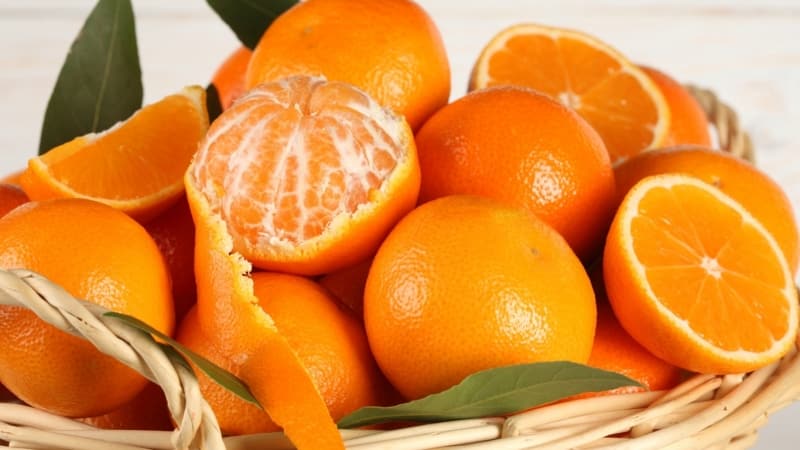
The table shows the chemical composition of the product per 100 g.
| Name | Content | Norm |
| Vitamin A | 10 mcg | 900 mcg |
| beta carotene | 0.06 mg | 5 mg |
| Vitamin B1 | 0.06 mg | 1.5 mg |
| Vitamin B2 | 0.03 mg | 1.8 mg |
| Vitamin B4 | 10.2 mg | 500 mg |
| Vitamin B5 | 0.216 mg | 5 mg |
| Vitamin B6 | 0.07 mg | 2 mg |
| Vitamin B9 | 16 mcg | 400 mcg |
| Vitamin C | 38 mg | 90 mg |
| Vitamin E | 0.2 mg | 15 mg |
| Vitamin H | 0.8 mcg | 50 mcg |
| Vitamin PP | 0.3 mg | 20 mg |
| Niacin | 0.2 mg | — |
| Potassium, K | 155 mg | 2500 mg |
| Calcium | 35 mg | 1000 mg |
| Silicon | 6 mg | 30 mg |
| Magnesium | 11 mg | 400 mg |
| Sodium | 12 mg | 1300 mg |
| Sulfur | 8.1 mg | 1000 mg |
| Phosphorus | 17 mg | 800 mg |
| Chlorine | 3 mg | 2300 mg |
| Aluminum | 364 mcg | — |
| Bor | 140 mcg | — |
| Vanadium | 7.2 mcg | — |
| Iron | 0.1 mg | 18 mg |
| Iodine | 0.3 mcg | 150 mcg |
| Cobalt | 14.1 mcg | 10 mcg |
| Lithium | 3 mcg | — |
| Manganese | 0.039 mg | 2 mg |
| Copper | 42 mcg | 1000 mcg |
| Molybdenum | 63.1 mcg | 70 mcg |
| Nickel | 0.8 mcg | — |
| Rubidium | 63 mcg | — |
| Selenium | 0.1 mcg | 55 mcg |
| Strontium | 60 mcg | — |
| Fluorine | 150.3 mcg | 4000 mcg |
| Chromium | 0.1 mcg | 50 mcg |
| Zinc | 0.07 mg | 12 mg |
| Mono- and disaccharides (sugars) | 7.5 g | max 100 g |
| Glucose | 2 g | — |
| Sucrose | 4.5 g | — |
| Fructose | 1.6 g | — |
| Saturated fatty acids | 0.039 g | max 18.7 g |
| Omega-3 fatty acids | 0.018 g | from 0.9 to 3.7 g |
| Omega-6 fatty acids | 0.048 g | from 4.7 to 16.8 g |
KBZHU
Nutritional value of 100 g of product without peel:
- calorie content – 38 kcal;
- proteins – 0.8 g;
- fats – 0.2 g;
- carbohydrates – 7.5 g;
- organic acids – 1.1 g;
- fiber – 1.9 g;
- water – 88 g;
- ash – 0.5 g.
How many calories are in 1 piece? The weight of one tangerine varies depending on the variety. The weight of one large citrus without peel is about 100 g. To calculate the calorie content of the product, use a simple formula: x = weight of the product * calorie content of the product / 100.
Example for 1 tangerine weighing 80 g:
- 100 g - 38 kcal;
- 80 g - x kcal;
- x = 80 * 38/100 ;
- x = 30.4 kcal.
Glycemic index
Tangerines are included in the group of foods with a low glycemic index. GI indicator – 40 units. This means that citrus is allowed to be consumed by people with diabetes in moderation. The product does not cause a sharp increase in blood sugar and provides a feeling of fullness for a long time.
Benefits for the body
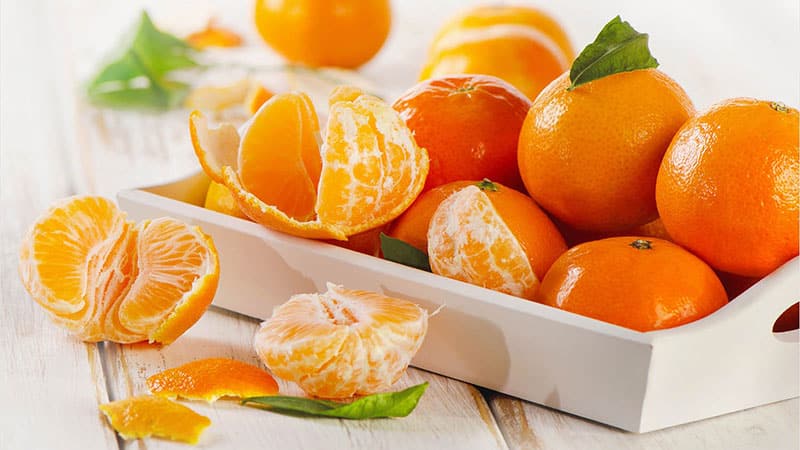
General benefits of tangerines for the human body:
- Antioxidants and vitamin C eliminate inflammation and prevent the formation of free radicals that cause oxidative processes.
- Essential oils calm the nervous system, reduce anxiety, nausea, headaches, and normalize sleep. In Minnesota hospitals, doctors installed aromatherapy lamps in their rooms. The result of the experiment was pleasantly surprising - the patients’ condition improved significantly, anxiety and restlessness went away.
- Mandarin has antibacterial properties and reduces microbial activity.
- Citrus promotes the formation of antitumor agents and helps fight cancer.
- Pectin and hemicellulose regulate blood cholesterol levels, promote the elimination of “bad” cholesterol and increase the level of “good” cholesterol.
- Fiber normalizes digestion and stool, regulates intestinal function, heals wounds and erosions in the stomach, and reduces gas formation.
- Regular consumption of tangerines prevents the development of stroke and heart muscle cancer.
- Citrus stops the development of sepsis thanks to essential oils that destroy bacteria.
- Tangerines accelerate cell renewal and reproduction of new ones.
- The product removes uric acid, salt and harmful substances from the body.
- Tangerine essential oil relieves spasms of the respiratory system and prevents the development of asthma.
- The fruits contain lutein, the visual pigment of our eyes. Without it, we would not be able to discern details. It maintains and improves visual acuity and prevents retinal dystrophy.
For women

Tangerines normalize the menstrual cycle, eliminate smooth muscle spasms, and alleviate the condition of women during menopause. Citrus restores vitality, gives a boost of energy, and prevents the development of depression.
During the period of bearing a child, it is useful to consume a small amount of tangerines (1-2 pieces per day). This helps eliminate toxicosis, swelling tissues, prevent the appearance of stretch marks on the skin.
Essential oil cleanses the skin, lightens acne, reduces scars and stretch marks. The delicate texture does not irritate the skin and prevents the development of bacterial and fungal infections. The oil is not used in its pure form, but mixed with almond or peach oil.
With regular consumption of tangerines, skin color improves, acne and inflammation on the face disappear, elasticity increases and the network of fine wrinkles decreases.
Ascorbic acid slows down the aging process of the skin, protects against the harmful effects of the environment, promotes collagen production.
Vitamins A and B12 help strengthen the hair follicle and reduce the secretion of sebum, slowing down the process of graying. Hair will remain fresh longer, become manageable and shiny.
For men

Tangerines have a positive effect on potency, increase the percentage of viable sperm, and enhance libido. Regular consumption of citrus fruits increases endurance, which is especially important during increased physical activity.
For children

Tangerine contains the least amount of vitamins and minerals compared to other citrus fruits, but this does not make it a useless product. Children love the slices with their pleasant sweet and sour taste. Mandarin stimulates the digestive function of a growing body, increases appetite, eliminates diarrhea and alleviates bronchitis.
Tangerine is considered one of the most powerful allergenic foods, so it is introduced into children's diets gradually and with extreme caution.Pediatricians recommend starting to get acquainted with citrus after a year of the baby’s life. Children suffering from allergic diseases are given tangerines after 3 years of age, starting with 1-2 slices.
One-year-old children are given tangerine juice diluted 1:1 with water. Start with 1 tsp. and gradually increase the portion to 100 ml.
Harm and contraindications
Contraindications for use of the product:
- epilepsy;
- disorders of the liver (hepatitis) and kidneys (nephritis, cholecystitis);
- inflammatory processes in the intestines;
- pathologies of the gastrointestinal tract;
- children's age less than 1 year;
- gastritis with high acidity;
- allergy.
Excessive consumption of citrus fruits causes hypervitaminosis. Many vitamins are not able to accumulate, and the body does not have time to break down the large flow of nutritional components. The result is a rash, upset stomach, low hemoglobin.
In what quantity and form should you consume tangerines?
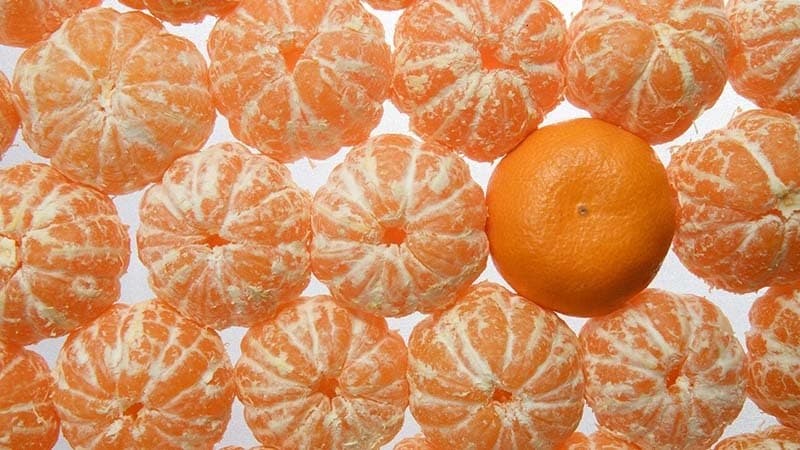
A specific daily intake of tangerines has not been established. However, it is important to use common sense and not overeat. A healthy person without an allergy to citrus fruits can eat about 500 g of the product, on average 3-5 pieces.
Before eating, it is advisable to wash the fruits with warm water and wipe with a waffle towel. Carriers often treat them with chemicals to increase product safety, as evidenced by a glossy, waxy sheen and stickiness.
To get the maximum benefit, citrus fruits are best consumed fresh. Prepare fresh fruits, add to salads, mix with natural yoghurts and cottage cheese. Canned slices in sugar syrup are available for sale. Such a product does not provide any benefit, and the calorie and sugar content is off the charts.
Reference. In Russia, Abkhazian tangerines are considered the most environmentally friendly. They are treated less than others with chemicals for better preservation. Their skin is bright yellow, the flesh is juicy, sweet and sour, almost seedless.
Use in cooking

Tangerines are consumed fresh and added to fruit, vegetable and meat salads. They decorate cakes and prepare open sweet pies from shortbread or biscuit dough. The skin and pulp are used to make candied fruits, jams, and jellies. The zest is brewed with green and black tea, ground into flour and used as a seasoning for baked goods and poultry.
In folk medicine
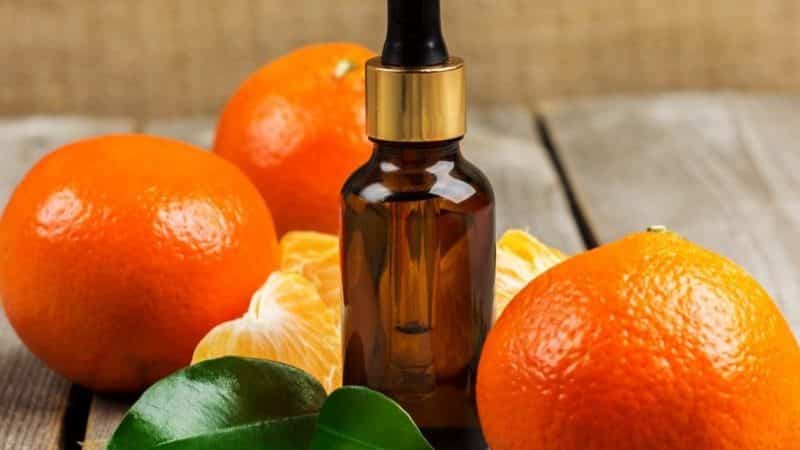
Most popular applications:
- Essential oil from the peel of tangerines is used for massage. It can be mixed with any oil base. Rubbing with aromatic oil helps reduce the appearance of cellulite, inflammation in the muscles, replenish energy and eliminate headaches.
- Naturopaths advise adding tangerine zest in tea to eliminate nausea during toxicosis.
- Ascorbic acid and phytoncides increase the body's defenses, increase its resistance to viruses and bacteria. The pulp contains phenolic acids and synephrine. They help remove mucus from the lungs and bronchi, excess fluid from tissues, and facilitate cough and speed up the healing process.
- To eliminate indigestion and constipation, it is recommended to drink a glass in the morning on an empty stomach. fresh tangerine juice.
- Decoction of zest helps cure tracheitis and bronchitis.
- Fresh juice used as an aid in the treatment of fungal infections of the skin and nails. The juice is applied to the affected areas with rubbing movements.
Official medicine allows the use of tangerine-based syrups for the treatment of ARVI. The zest is included in some medicines to improve the taste. Citrus-based drugs are used to treat gout and eliminate edema in combination with basic medications.
How to select and store
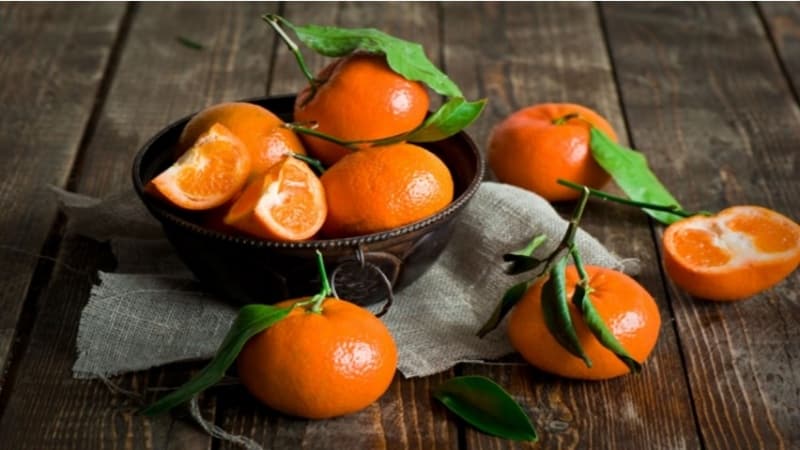
Rules for choosing fruit with excellent taste:
- Give preference to weighty fruits - the greater the weight, the juicier the pulp.
- The sweetest tangerines have a bright orange, dense peel and weigh more than the sour ones. Such fruits contain the maximum amount of vitamin A.
- The skin should be free of mold, soft spots and dents. Their presence indicates a violation of the rules of storage and transportation.
- Flattened, large-fruited fruits with yellow skin, often sour.
- Press your fingernail on the skin - if the juice splatters, it means the fruit is ripe.
Storage rules:
- After purchasing, store tangerines in the refrigerator. There they stay fresh for more than a week. Rinse them with warm water, wipe dry with a waffle towel and store.
- Tangerines are best stored in high humidity conditions. Place fruits in the fruit and vegetable compartment.
- A plastic bag is not the best option for maintaining product freshness. Replace it with a regular mesh. Most often, packaged tangerines are sold in them.
- To increase shelf life, rub the fruits with refined sunflower oil.
- Tangerines with ponytails stay fresh longer.
This is interesting:
What is a pomegranate, is it a citrus or not?
Is it possible to drink carrot juice during pregnancy?
A nourishing buckwheat diet for 10 days for safe weight loss.
Conclusion
Tangerines are no less popular than other citrus fruits.There is a special rush in stores on the eve of the New Year holidays, and it is not surprising - the tangerine season lasts from November to January.
The fruits contain a large amount of ascorbic acid, the main amount of which is concentrated in the peel, vitamin A, E, potassium, calcium, silicon and other useful substances. Essential oil is extracted from the peel and used in folk medicine for rubbing, massage, and aromatherapy. The zest is brewed together with black and green tea, and the pulp is used to make delicious fresh juice, salads and pie fillings.